Amalgam dental filling is one of the widely used filling materials in dentistry in the past years. What is Amalgam Dental Filling? Is it true that amalgam dental fillings are toxic? Let’s find the accurate answer to this question with BeDental.
What is Amalgam Dental Filling?
What is Amalgam Dental Filling? Amalgam is also known as an alloy. It is a product created by combining mercury with other metals such as copper, zinc, lead, etc. Chemically, amalgam can exist in liquid, solid, or powder forms. The physical state of amalgam depends on the amount of mercury it contains.
According to records, the history of amalgam dates back to the Tang Dynasty in China around the year 659. In Europe, amalgam was first used around 1528. Then, in 1800, amalgam dental filling materials were used more widely, especially in dental clinics.
Amalgam dental filling is also known as the lead filling method. This technique is applied to cases of decayed, cracked, or broken teeth. The ratio of metal and mercury in amalgam dental fillings is carefully formulated to avoid concentration errors. Amalgam dental filling is often applied to posterior teeth due to its durability and lack of aesthetic requirements.
However, in 2018, the EU issued a ban on the use of amalgam for children and pregnant women. This news has caused many users to feel extremely worried about the potential consequences of previously filled amalgam dental fillings.
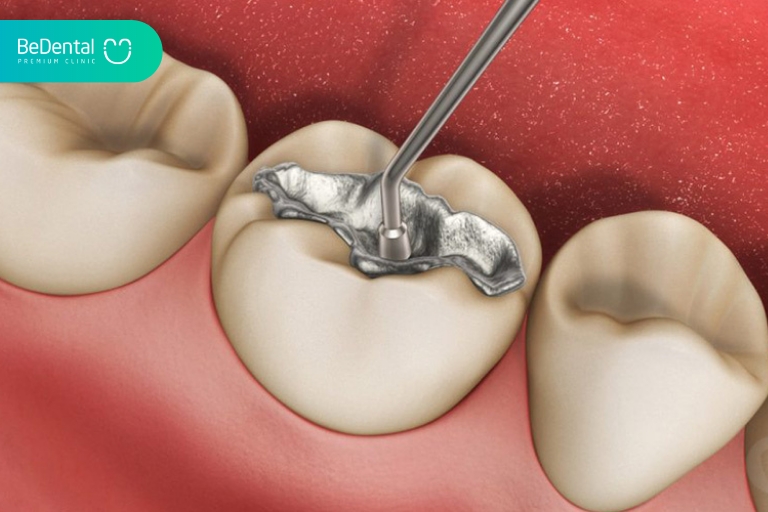
Characteristics of Amalgam Dental Filling Used in Dentistry
Amalgam dental filling will be carefully prepared by the dentist according to the correct ratio. Amalgam powder will be mixed with mercury and then placed into the prepared cavity. The dentist will pack it tightly and sculpt it to fit the damaged area on the tooth. Before the filling hardens, careful sculpting is done to ensure both safety and aesthetics.
In terms of the characteristics of Amalgam dental filling, users highly appreciate its durability and longevity. Therefore, Amalgam material is often used for filling and restoring the aesthetics of teeth in the back of the mouth. However, for front teeth, Amalgam metal filling may not be suitable due to lower aesthetic outcomes.
Previously, Amalgam material was considered safe, effective, and long-lasting, which is why it was widely used in cosmetic dentistry treatments. When placing Amalgam into the prepared cavity, the material will harden within a few minutes. At this point, the dentist can easily sculpt it. The final hardening time is about 24 hours, after which it cannot be adjusted.
Do dental crowns require anesthesia? The process of getting dental crowns with anesthesia
Regarding the toxicity of Amalgam dental filling, it is important to note that the use of Amalgam has been controversial due to the presence of mercury.
However, numerous scientific studies and the American Dental Association have stated that the amount of mercury released from Amalgam fillings is minimal and does not pose significant health risks. It is important to consult with your dentist to determine the best dental filling material for your specific needs and concerns.
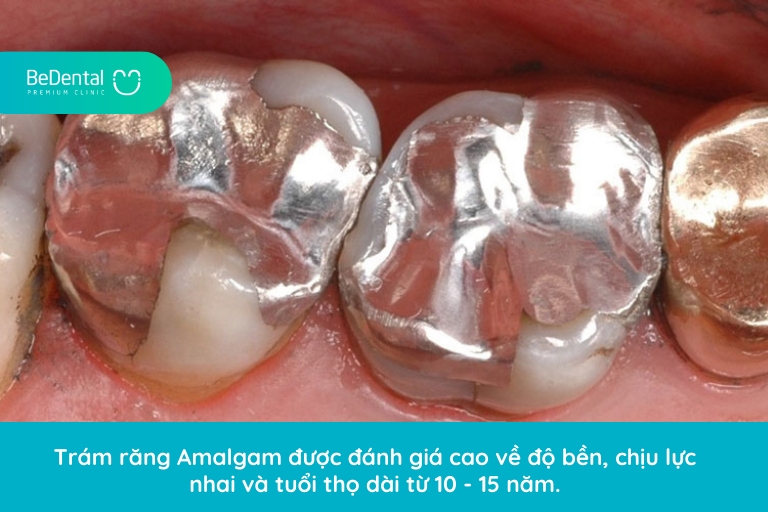
Advantages of Amalgam Dental Filling Method
It can be said that the emergence of Amalgam has opened up a new era of cosmetic dentistry. For cases of mild to moderate tooth decay or cracked and broken teeth, dental filling and bonding are the most effective methods. Meanwhile, Amalgam possesses many outstanding advantages compared to other dental restoration techniques.
Here are the advantages of Amalgam dental filling material:
Easy application by the dentist
Amalgam material used in dental filling and bonding is usually in a malleable form. During the procedure, the dentist only needs to place Amalgam on top of the tooth and sculpt it to fit the tooth’s damage.
What is an implant-supported removable denture? Is it truly worth using?
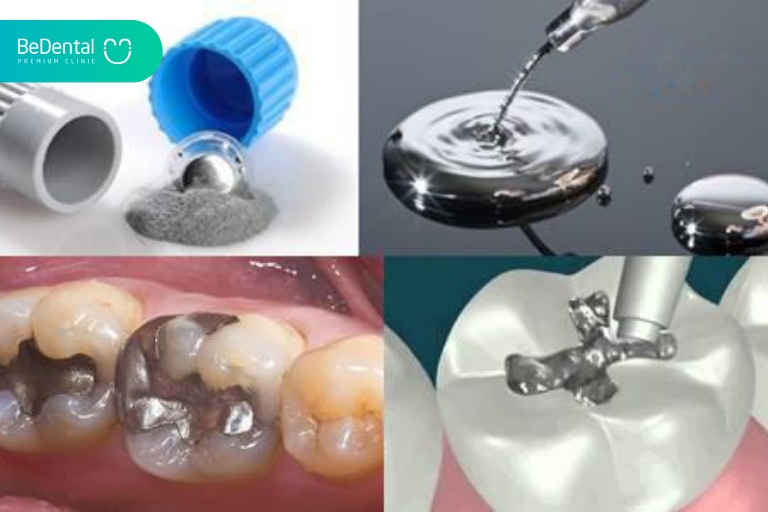
Provides good aesthetic restoration
When teeth are damaged due to decay or external forces causing cracks, fractures, or spacing, dental filling is the perfect solution. Thanks to its malleable structure, Amalgam can be sculpted to fit the tooth’s imperfections.
Especially for cases of larger tooth damage, when other filling materials cannot or are difficult to use, Amalgam is the best choice.
Ensures stable chewing function
After the Amalgam filling is placed, it hardens and has excellent durability. It can be said that Amalgam is almost perfectly rigid. Therefore, not only is the tooth damage repaired, but the Amalgam filling also protects the tooth, making chewing food simple and comfortable without the need to avoid or chew on the affected tooth as before.
Moreover, Amalgam is a highly durable material, with good resistance to chewing forces and a long lifespan. In fact, the lifespan of an Amalgam filling can reach up to 10 years without any chipping or falling out if it is carefully cared for.
Cost-effective
Performing Amalgam filling also helps optimize the cost of cosmetic dental treatment. Compared to other filling materials, Amalgam is much cheaper. Additionally, due to its high durability, the need for re-filling is rare.
Disadvantages of Amalgam dental filling method
Along with its many outstanding advantages, Amalgam also has a few disadvantages, such as:
Relatively low aesthetic appearance
Amalgam fillings have a silver color. Therefore, if the filling is done in the back teeth, it does not affect aesthetics. However, when filling the front teeth, the aesthetic outcome may not be satisfactory. For front teeth filling, you can consider other materials such as porcelain or composite.
How to Stop Bleeding after Wisdom Tooth Extraction? Some Ways to Control Bleeding
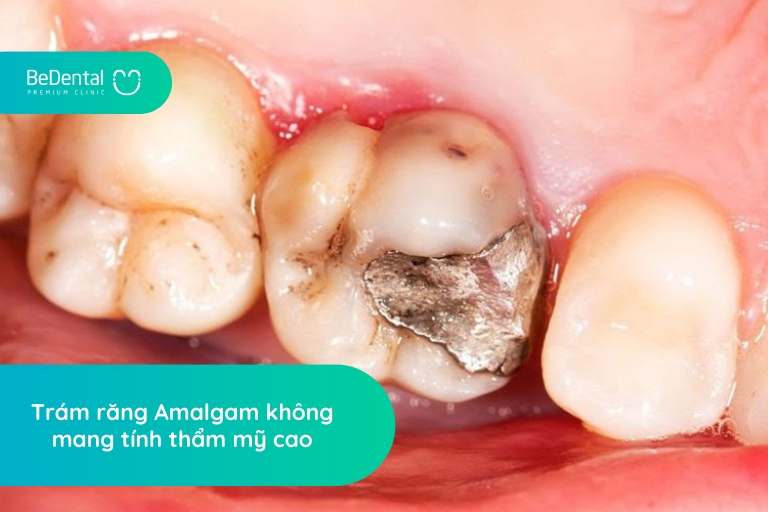
Possibility of discoloration
During daily eating and drinking, consuming acidic or colored foods can cause tooth discoloration. Amalgam can come into contact with these substances and change color from its original state. Additionally, adjacent teeth to the Amalgam filling can also be affected.
Some cases of thermal conductivity
Amalgam is a material with good thermal conductivity. Therefore, consuming extremely hot or cold food can make your teeth more sensitive. This can cause discomfort and pain, making eating and drinking more difficult.
Potential for allergies
Amalgam contains mercury and other metals such as copper, tin, silver, etc. Therefore, for individuals who are sensitive to metals, Amalgam fillings can cause pain, discomfort, or even dislodgment of the filling.
Can damage tooth enamel and tooth structure
When performing Amalgam filling, the dentist needs to create a cavity to pour the Amalgam into. This can invade and affect both enamel and tooth structure.
How long does Amalgam dental filling last?
The durability of Amalgam fillings is highly regarded. In reality, the filling can last on the tooth for 5-6 years, or even up to 10 years with careful diet and oral hygiene.
Additionally, the lifespan of Amalgam fillings also depends on the dentist’s filling technique. Choosing a reputable dental clinic to perform Amalgam filling ensures the highest durability of the filling.
Is Amalgam dental filling toxic?
The question of whether Amalgam dental filling is toxic or not is a common concern among users. It is known that Amalgam contains a mixture of mercury and other metals. When Amalgam filling is performed, mercury can be released in small amounts as vapor. If inhaled, especially in higher doses, it can affect human health.
Mercury can cause neurotoxicity when exposed to high concentrations for a long time. Prolonged accumulation of mercury in the body can cause chronic toxicity, severely affecting health. For example, it can reduce natural resistance, damage organs such as the kidneys and liver. Additionally, mercury poisoning can particularly affect the nervous system and intelligence.
However, the release of mercury from dental filling materials is low, so its toxicity in clinical practice has not been recognized. Furthermore, the FDA has conducted studies to determine the toxicity of Amalgam. The results show that Amalgam dental filling is safe for adults and children aged 6 and above. Clinical studies also show no correlation between Amalgam fillings and health issues in these individuals. To ensure safety, it is recommended to seek treatment at reputable dental clinics.
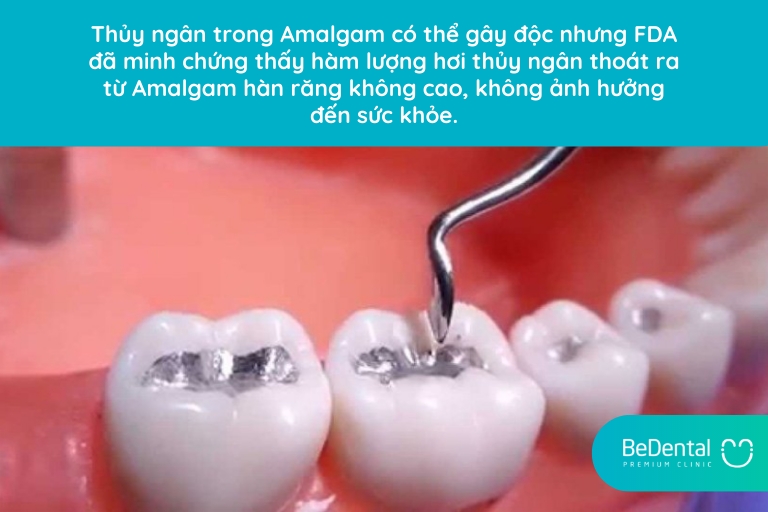
Who should absolutely not have Amalgam dental filling?
Although clinical studies have not found evidence of mercury exposure, Amalgam can lead to a range of negative health effects. However, according to the latest recommendations from the FDA, there are certain groups of people who should not use Amalgam dental filling, including children and pregnant women.
Specifically, Amalgam filling is contraindicated for:
- Children under 6 years old.
- Women who are planning to become pregnant or are currently pregnant.
- Women who are breastfeeding.
- Individuals with pre-existing neurological conditions.
- Individuals with impaired kidney function.
- Individuals who are sensitive to mercury or metals.
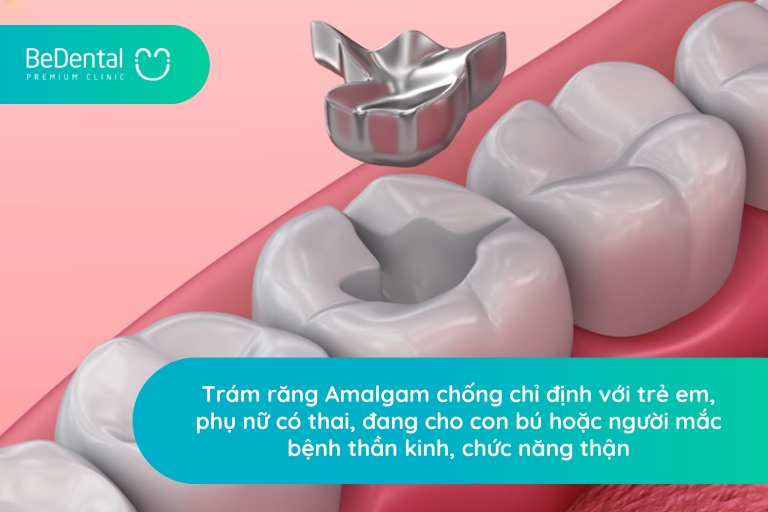
Note: The FDA also does not recommend anyone who has used or is currently using Amalgam dental fillings to have them replaced or removed. This is because this is the stage where mercury can release the highest amount of vapor. The removal of Amalgam should only be done if necessary for medical reasons. The removal of Amalgam can temporarily increase exposure to mercury vapor and can also damage the healthy structure of the teeth, leading to more risks or dangerous complications.
Which dental filling material is safer to replace Amalgam?
Although the amount of mercury in Amalgam does not significantly affect human health, to ensure absolute safety, you can choose other safer dental filling materials such as composite, porcelain, or GIC.
Composite dental filling
Composite is the safest, most effective, and most popular dental filling material today. Compared to Amalgam, composite has many superior advantages in terms of both aesthetics and health safety.
Composite dental fillings use composite resin material that closely matches the color of natural teeth. Therefore, if not observed carefully, it is difficult to tell if there is a dental filling or not. For front teeth, composite dental fillings can also be performed with confidence.
In addition, when using composite for dental fillings, it does not cause as much invasion as Amalgam fillings. Besides filling, composite can also be used to repair chipped or worn teeth.
Importantly, composite material does not contain any harmful substances for the body. You can use it with peace of mind without worrying too much.
Porcelain dental filling
Dental porcelain filling technique, also known as Inlay Onlay, can be used for any dental imperfections, without being selective like Amalgam.
In terms of advantages, dental porcelain has a color that matches the natural color of teeth, so the aesthetic effect is extremely high. In addition, the durability of porcelain is long-lasting and does not change color over time like Amalgam.
Using dental porcelain for filling also helps maintain oral hygiene and ensure stable chewing function. Porcelain is quite hard, so its durability and ability to withstand force are highly evaluated. Overall, dental porcelain is currently one of the highly regarded dental filling materials due to its comprehensive advantages.
GIC dental filling
GIC is a dental cement material that was developed after Amalgam. Compared to Amalgam, GIC is safer and provides much higher aesthetics. GIC has a powdery white color and is made into artificial tooth enamel to fill deep cavities or cracks, fractures, and chips on the teeth.
In particular, the GIC dental filling technique does not require any tooth grinding, so it maximally preserves the natural teeth. Moreover, GIC material also contains fluoride – a substance that prevents tooth decay. Therefore, GIC dental fillings not only restore aesthetics but also prevent bacterial invasion and tooth decay.
Although Amalgam dental filling material has many advantages, considering the price and safety, you should still choose other dental filling techniques such as composite or porcelain Inlay Onlay. We hope the information in the article has helped you learn more about the toxicity of Amalgam dental fillings and which dental filling material is the best. If you need more specific advice, please contact BeDental for support.
Price list for you to refer
| Danh mục | Unit | Giá thành | |
|---|---|---|---|
| 1.Teeth filling (More detail...) | |||
| Baby teeth filling | 1 Unit | 250.000 ~ 10$ |
|
| Permanent Teeth Filling | 1 Unit | 500.000 ~ 20$ |
|
Cosmetic Filling | 1 Unit | 700.000 ~ 28$ |
|
Sensitive teeth filling | 1 Unit | 500.000 ~ 20$ |
|
| Composite bonding | 1 Unit | 1.000.000 ~ 40$ |
|
| 2.Root Canal Treatment - Anterior by endodontist machine (More detail...) | |||
| Root Canal Treatment - Anterior for baby teeth | 1 Unit | 800.000 ~ 31$ |
|
| Root Canal Treatment - Anterior for Front teeth | 1 Unit | 1.200.000 ~ 47$ |
|
| Root Canal Treatment - Anterior for Premolar teeth | 1 Unit | 1.500.000 ~ 59$ |
|
| Root Canal Treatment - Anterior for molar teeth | 1 Unit | 2.000.000 ~ 79$ |
|
| 3.Root Canal reTreatment - Anterior by endodontist machine | |||
| Root Canal Treatment - Anterior for Front teeth by endodontist machine | 1 Unit | 1.500.000 ~ 59$ |
|
| Anterior for Premolar teeth by endodontist machine | 1 Unit | 1.800.000 ~ 71$ |
|
| Anterior for molar teeth by endodontist machine | 1 Unit | 2.300.000 ~ 90$ |
|
| 4 Vecniflour dental care (More detail...) | |||
| Vecniflour dental care for child | 1 Unit | 500.000 ~ 20$ |
Tư vấn chuyên môn bài viết:
BÁC SĨ ĐÀM TRỌNG HIẾU
BEDENTAL - TOP STANDARD DENTISTRY SYSTEM
In HANOI
Address 1: 7B Thi Sach St, Ngo Thi Nham, Hai Ba Trung Dist, Ha Noi. - 0934.61.9090
Address 2: No 129 Hoang Ngan, Yen Hoa, Cau Giay Dist, Ha Noi. - 0934.61.9090
In HO CHI MINH
Address 1: 53 -55 -57 Pho Duc Chinh St, Nguyen Thai Binh, Dist. 1, Ho Chi Minh. - 0766.00.8080
Working: 9am - 8pm everyday
Website: https://bedental.vn/en/





